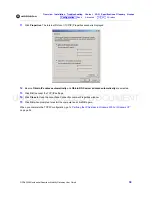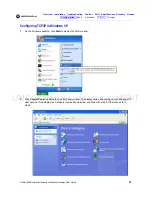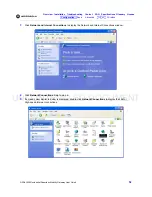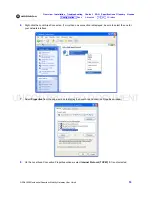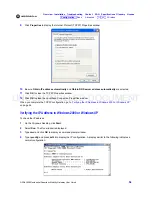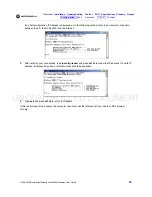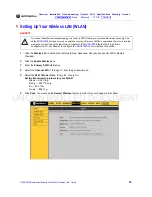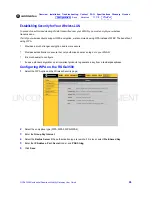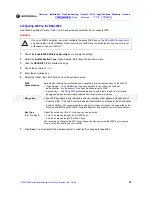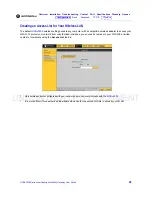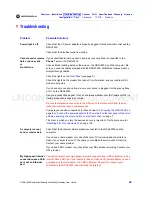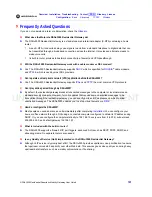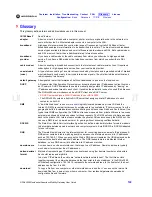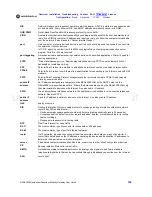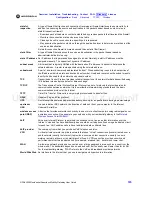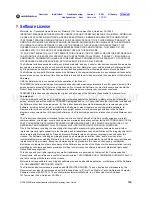
RSGu3500 Residential Seamless Mobility Gateway User Guide
103
Overview Installation Troubleshooting
Basic Advanced TCP/IP Wireless
downstream
In a cable data or DSL network, the direction of data received by your computer from the Internet.
driver
Software that enables a computer to interact with a network or other device. For example, there are
drivers for printers, monitors, graphics adapters, modems, Ethernet, USB, and many others.
DSL
A digital subscriber line enables a broadband connection to the Internet over traditional telephone
lines that support DSL. You need a subscription for DSL service from your local telephone company.
dynamic IP
address
An IP address that is temporarily leased to a host by a DHCP server. The opposite of
static IP
address
.
Ethernet
The most widely used type of local area network (LAN). The most commonly installed Ethernet
networks are called 10Base-T. 10Base-T provides transmission speeds up to 10 megabits per
second (Mbps), usually over twisted-pair wire. Fast Ethernet (100Base-T) provides transmission
speeds up to 100 Mbps.
F-type connector
A type of connector used to connect coaxial cable to equipment such as the RSGu3500.
firewall
A security software system on the RSGu3500 that enforces an access control policy between the
Internet and the RSGu3500 LAN.
flow
A data path moving in one direction.
GUI
graphical user interface
HFC
A hybrid fiber/coaxial cable network uses fiber-optic cable as the trunk and coaxial cable to the
subscriber premises.
host
Any computer or similar device supporting end-user applications or services with full two-way
network access. Each host has a unique host number that combined with the network number forms
its IP address.
hub
On a LAN, a device that connects multiple hosts to the LAN. A hub performs no data filtering. See
also
router
.
IGMP
Internet Group Management Protocol
Internet
A worldwide collection of interconnected networks, all using TCP/IP.
IP
Internet Protocol is a set of standards that enable different types of computers to communicate with
one another and exchange data through the Internet. IP provides the appearance of a single,
seamless communication system and makes the Internet a virtual network.
IP address
An Internet Protocol address identifies a computer or other device on a TCP/IP network. Networks
using the TCP/IP protocol route messages based on the destination IP address.
IPSec
The Internet Protocol Security protocols are authentication and encryption standards for secure data
exchange over the Internet.
ISP
Internet service provider
LAN
A local area network provides a full-time, high-bandwidth connection over a limited area, such as a
building, campus, office, or home. The computers and other devices you connect to your residential
gateway, except for the telephones, form a LAN. Ethernet is the most widely used LAN standard.
MAC address
The Media Access Control address uniquely identifies each device that can be connected to an
Ethernet network. It is permanently written to read-only memory (ROM) at the factory and printed on
your RSGu3500.
MHz
Mega hertz. A measure of frequency; one MHz means one million cycles per second.
MPPC
Microsoft Point-To-Point Compression protocol is a method for compressing PPP packets to
optimize processor and bandwidth usage for many simultaneous connections. MPPC is patented in
the United States by Hifn Inc.
MPPE
Microsoft Point-to-Point Encryption is a protocol for encrypting data across PPP and VPNs. It is
frequently used in conjunction with MPPC.
NAT
Network Address Translation is a standard for a LAN to use one set of IP addresses for internal
traffic and a second set of IP addresses for external traffic.
NAPT
Network Address Port Translation is the most common form of translation between public and
private IP addresses.
network
Two or more computers connected to communicate with each other. Networks have traditionally
been connected using some kind of wiring.

